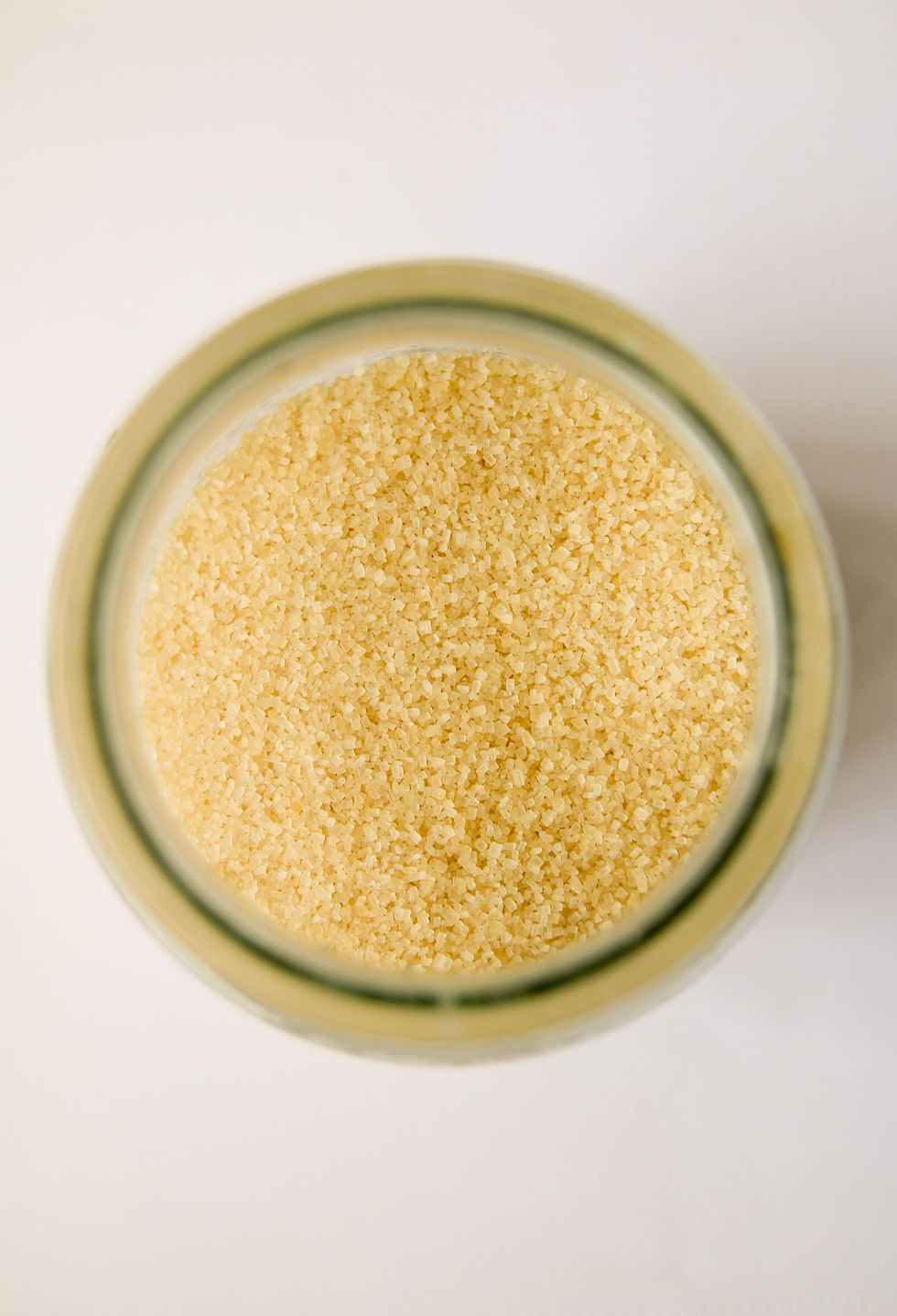
Ever asked yourself what really is Corn Syrup and why is it in my food? Perhaps you are new to gummy development and arn't sure what kind of corn syrup you should source.
Simply speaking, corn syrup is a liquid sweetener derived from corn starch. It is commonly used in a wide variety of food products, from baked goods and candies such as gummies, to sauces and beverages. Its widespread use in the food industry has caused it to be a massive source of debate in the US with regards to its prevalence and health implications (which we won't get into here). There are several different types of corn syrup, each with their own unique properties and uses. Having used a variety of types of corn syrups throughout my career in different applications, I can provide an insider’s perspective on the importance of this widely debated and villainized ingredient.
In this post, we will explore the different types of corn syrup and corn syrup alternatives and their applications in food products. We'll take a look at:
Regular Corn Syrup (or Glucose Syrup)
High Fructose Corn Syrup
Corn Syrup Solids
High Maltose Corn Syrup
And Corn Syrup Alternatives (Agave, Tapioca and Rice)
We’ll also discuss how corn syrup plays an important role in gummy formulation and what aspects of corn syrup are important to consider when developing confections and other food products.
1. Regular Corn Syrup

First there is “regular” corn syrup, also known as glucose syrup or corn sugar. Corn Syrup is a type of syrup that contains mainly glucose molecules (a monosaccharide that makes up 50% of common table sugar). It is made by breaking down corn starch with enzymes to a pre-determined percentage of glucose monosaccharides and then refining the resulting syrup to remove impurities resulting in a thick liquid sweetener.
Regular corn syrup tastes less sweet than high fructose corn syrup (glucose molecules are less sweet than fructose) and is often used in baked goods, bars, jams, and sauces to bind, prevent crystallization and improve texture. So what is its importance in gummy formulation?

In gummy (and other product) formulation, corn syrup serves multiple purposes:
1. Introduces sugars - but since its perceived sweetness if less than table sugar it balances out the other sugars
2. Provides bulk to the formula
3. Prevents crystallization - preventing your gummies from turning into sandy disaster over time.
It’s important to keep in mind when formulating a gummy or other food product that there are subtypes of corn syrups available. When sourcing a corn syrup, you will need to keep in mind the two numbers used by the manufacturer that can significantly impact your final result.
The first number indicates the Dextrose Equivalent or “DE” number which is the quantity of reducing sugars - an important number when considering your processing conditions. The higher the DE value, the higher likelihood of browning reactions occurring during your manufacturing. Sometimes this is desirable and sometimes not. The second number is the sweetness level, which is simply a ratio of sweetness compared to standard table sugar sweetness.
42/43 DE Corn Syrup, for example, is stopped during the enzymatic breakdown process when the corn starch is a sweetness 42% relative to the sweetness of granulated sugar and a Dextrose Equivalent of 43 (which is in the middle range and provides a moderate amount of reducing sugars to your formula). This results in a light colored but very thick corn syrup that provides bulk and texture without contributing a sickeningly sweet taste to foods. Beyond this there are many other corn syrups on the market for you to choose from when formulating your foods.
2. High Fructose Corn Syrup (HFCS)

Then there is probably the most widely used and hated of the corn syrup family, High Fructose Corn Syrup (HFCS).
High Fructose Corn Syrup is a type of corn syrup that has been modified to increase its fructose content. HFCS is produced by extending the enzymatic breakdown of regular corn syrup to convert a portion of glucose into fructose. The resulting syrup is thinner than regular corn syrup and tastes sweeter, containing around 42-55% fructose compared to 0% in regular corn syrup.
HFCS is used in many food products globally, including soda, candy, and baked goods to add sweetness and functionality. It is commonly used in processed foods and beverages because it is cheaper than granulated sugar and has a long shelf life. Due to its higher water content and sweetness intensity, HFCS is not typically used in gummy manufacturing because it means more water to drive off during processing and can taste cloying.

Where HFCS is most useful is in prolonging the shelf life of other foods, such as baked goods, because it acts as a humectant, meaning it helps foods retain moisture and in baked goods that means softer bread less prone to going stale. With a high DE content, HFCS also aids in browning reactions, generating those drool-worthy pizza crusts and breads we all love.
HFCS has become the villain of the ingredient world after receiving a mountain of bad PR over the years and due to its prevalent use in processed foods and the link to increasing rates of obesity, heart disease, and diabetes in the US. Others consider HFCS as artificial and linked to health concerns, but it should be noted that any sugar product in excess can result in the same health issues. It seems HFCS was an easy target due to a few factors, but mostly due to its widespread use as an added sugar.
3. Corn Syrup Solids

Then there are corn syrup solids. CSS are a type of corn syrup that has been dehydrated into a powder form. Corn syrup solids are often used in place of regular corn syrup in dry mixes because they are easier to store and transport (read: longer shelf life, smaller footprint in your warehouse, PLUS lower shipping costs).

CSS’s are commonly used in food products such as baby formula, soups, and sauces as a thickener or to add sweetness where you don’t want or need the added water content. You can also use corn syrup solids to replace liquid corn syrup in formulas where you need to reduce the water content but have no other way to do so. The added flexibility of corn syrup solids means you can control how much water you add back to the finished product. However, caution should be used when formulating with Corn Syrup Solids, because the amount of moisture added now depends on you as the manufacturer.
4. High Maltose Corn Syrup (HMCS)
High maltose corn syrup (HMCS) is a type of corn syrup that contains a higher percentage of maltose than regular corn syrup, minimally 50%. It is made by adding enzymes to corn starch in a controlled environment to break down the saccharide molecules into the disaccharide Maltose. HMCS is commonly used in brewing and as a sweetener in confectionery products. It is also preferred in frozen dessert products due to its low freezing point, adding sweetness while maintaining softness.

HMCS has a lower DE than table sugar and is a good alternative to other corn syrups, especially in tropical climates, because it is less hygroscopic (meaning is attracts and retains moisture less than other corn syrups). This is important to keep in mind when formulating confections (hard candies, toffees and gummies) in a region where you might have humidity control issues.
Lastly, HMCS has become a preferred alternative of HFCS for manufacturers because it does not carry the same negative perception, although corn syrups in general still carry a negative connotation compared to other liquid sweeteners.
5. Other Liquid Syrups
As growing concern and fear of consumption of processed corn sugars grows, its important to know what alternatives are out there that work similarly to corn syrup but carry a different name and connotation. The following options offer a cleaner label perception non-GMO alternative but keep in mind they may cost more and consistent supply may be a determent.

Tapioca syrup is probably the most widely known and used alternative to traditional Corn Syrup. Derived from the root crop Cassava, it offers the same benefits for formulators and can be used interchangeably in application, as well as offering a clean taste and label connotation with availability offered in both non-GMO and organic options. And just like Corn Syrup, Tapioca Syrups come in different DE's with applications dependent on your desired end result and sweetness level.

Agave is another popular alternative, having similarities to HFCS and corn syrup, but does provide a different flavor profile. There are different color grades and there are limits on the applications due to its source. Price on Agave has traditionally been higher than other liquid sweeteners due to its lengthy growth cycle and demand from the tequila industry. However, Agave has a significantly higher consumer perception than other sweeteners.

Rice Syrup is another clean label alternative to corn syrup, and again, is offered in different DE levels and colors for formulators to use in their application. Generally speaking, Rice Syrup, Tapioca and Corn are almost interchangeable, with minor factors in price and availability coming into play.
Its important to keep in mind what impact the different type of liquid sweetener used in your end product will have on your consumers purchasing decisions. The New Flavor combines Market Research and an in depth understanding of applications and costs analyses to form a holistic approach to help our customers design products that meet their consumers needs and generate revenue.

Corn syrup is a versatile sweetener that is used in many different food products. The different types of corn syrup have varying levels of sweetness and properties that make them suitable for different applications. High fructose corn syrup is commonly used in processed foods and beverages, while regular corn syrup is often used in baked goods, confections, and sauces. Corn syrup solids are used as thickeners or fillers, while High Maltose Corn Syrup is more commonly used in brewing and specialty confectionery and desserts. Alternative liquid sweeteners exist if you are looking for a non-corn based product for clean label or Non-GMO formulations.
Understanding the different types of corn syrup and its capabilities in application can help you make informed decisions about the formulations you work on in product development. For more information and assistance determining what kind(s) best suit your needs, reach out to The New Flavor for formulation advice.
Comentarios